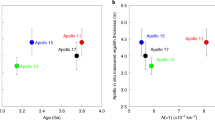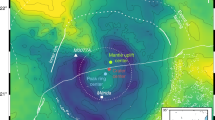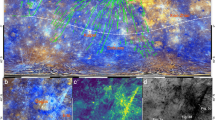Abstract
Rimmed grooves, lineations and elongate craters around Mare Imbrium shape much of the nearside Moon. This pattern was coined the Imbrium Sculpture1, and it was originally argued that it must have been formed by a giant oblique (~30°) impact, a conclusion echoed by later studies2. Some investigators, however, noticed that many elements of the Imbrium Sculpture are not radial to Imbrium, thereby implicating an endogenic or structural origin3,4. Here we use these non-radial trends to conclude that the Imbrium impactor was a proto-planet (half the diameter of Vesta), once part of a population of large proto-planets in the asteroid belt. Such independent constraints on the sizes of the Imbrium and other basin-forming impactors markedly increase estimates for the mass in the asteroid belt before depletion caused by the orbital migration of Jupiter and Saturn5. Moreover, laboratory impact experiments, shock physics codes and the groove widths indicate that multiple fragments (up to 2% of the initial diameter) from each oblique basin-forming impactor, such as the one that formed Imbrium, should have survived planetary collisions and contributed to the heavy impact bombardment between 4.3 and 3.8 billion years ago.
This is a preview of subscription content, access via your institution
Access options
Subscribe to this journal
Receive 51 print issues and online access
$199.00 per year
only $3.90 per issue
Buy this article
- Purchase on Springer Link
- Instant access to full article PDF
Prices may be subject to local taxes which are calculated during checkout



Similar content being viewed by others
References
Gilbert, G. K. The Moon’s face: a study of the origin of its features. Science 21, 305–307 (1893)
Baldwin, R. B. The Measure of the Moon (Univ. of Chicago Press, 1963)
Hartmann, W. K. Radial structures surrounding lunar basins, I: the Imbrium System. Commun. Lunar Planet. Lab. 2, 1–16 (1964)
Strom, R. G. Analysis of lunar lineaments, I: tectonic maps of the Moon. Commun. Lunar Planet. Lab. 2, 205–216 (1964)
Gomes, R., Levison, H. F., Tsiganis, K. & Morbidelli, A. Origin of the cataclysmic Late Heavy Bombardment period of the terrestrial planets. Nature 435, 466–469 (2005)
Spudis, P. D. The Geology of Multi-Ring Impact Basins (Cambridge Univ. Press, 1993)
Wilhelms, D. E. Secondary impact craters of lunar basins. Proc. Lunar Planet. Sci. Conf. 7, 2883–2901 (1976)
Andrews-Hannah, J. C. et al. The structure and evolution of the lunar Procellarum region as revealed by GRAIL. Nature 514, 68–71 (2014)
Wilhelms, D. E. The Geologic History of the Moon Professional Paper 1348 (US Geological Survey, 1987)
Oberbeck, V. R. The role of ballistic erosion and sedimentation. Rev. Geophys. Space Phys. 13, 337–362 (1975)
Anderson, J. L. B., Schultz, P. H. & Heineck, J. T. Asymmetry of ejecta flow during oblique impacts using three-dimensional particle image velocimetry. J. Geophys. Res. 108, 5094 (2003)
Hermalyn, B., Schultz, P. H. & Heineck, J. T., Early-stage coupling for oblique impacts into granular material. 41st Lunar Planet. Science Conf. Abstract no. 2565 (2010)
Schultz, P. H. & Wrobel, K. Downrange impact melt and related effects from Hale Crater on Mars. J. Geophys. Res. 117, E04001 (2012)
Schultz, P. H. & Gault, D. E. Prolonged global catastrophes from oblique impacts. Spec. Pap. Geol. Soc. Am. 247, 239–261 (1992)
Crawford, D. A. & Schultz, P. H. A model of localized shear heating with implications for the morphology and paleomagnetism of complex craters. Large Meteorite Impacts Planet. Evol. V 047 (2013)
Schultz, P. H., Stickle, A. M. & Crawford, D. A. Effect of asteroid decapitation on craters and basins. 43rd Lunar Planet. Science Conf. Abstract no. 2428 (2012)
Schultz, P. H. & Crawford, D. A. Lunar basin-forming projectiles. 45th Lunar Planet. Science Conf. Abstract no. 1961 (2014)
Schultz, P. H. & Crawford, D. A. Origin of the nearside structural and geochemical anomalies on the Moon. Spec. Pap. Geol. Soc. Am. 477, 141–159 (2011)
Schmidt, R. M. & Housen, K. R. Some recent advances in scaling of impact and explosion cratering. Int. J. Impact Eng. 5, 543–560 (1987)
Yue, Z. et al. Projectile remnants in central peaks of lunar impact craters. Nature Geosci. 6, 435–437 (2013)
Joy, K. H. et al. Direct detection of projectile relics from the end of the lunar basin-forming epoch. Science 336, 1426–1429 (2012)
Bottke, W. F. et al. An Archeaean heavy bombardment from a destabilized extension of the asteroid belt. Nature 485, 78–81 (2012)
McGlaun, J. M., Thompson, S. L. & Elrick, M. G. A three-dimensional shock wave physics code. Int. J. Impact Eng. 10, 351–360 (1990)
Collins, G. S., Melosh, H. J. & Ivanov, B. A. Modeling damage and deformation in impact simulations. Meteorit. Planet. Sci. 39, 217–231 (2004)
Senft, L. E. & Stewart, S. T. Dynamic fault weakening and the formation of large impact craters. Earth Planet. Sci. Lett. 287, 471–482 (2009)
Schultz, P. H., Ernst, C. E. & Anderson, J. L. B. Expectations for crater size and photometric evolution from the Deep Impact Collision. Space Sci. Rev. 117, 207–239 (2005)
Potter, R. W. K., Kring, D. A., Collins, G. S., Kiefer, W. S. & McGovern, P. J. Estimating transient crater size using the crustal annular bulge: insights from numerical modeling of lunar basin-scale impacts. Geophys. Res. Lett. 39, L18203 (2012)
Schultz, P. H., Orphal, D. L., Miller, B., Borden, W. F. & Larson, S. A. in Multi-Ring Basins (eds Schultz, P. H. & Merrill, R. B. ) Vol. 12A, 181–195 (1981)
Schultz, P. H. Atmospheric effects on ejecta emplacement and crater formation on Venus from Magellan. J. Geophys. Res. 97, 16183–16248 (1992)
Pierazzo, E. & Melosh, H. J. Hydrocode modeling of oblique impacts: the fate of the projectile. Meteorit. Planet. Sci. 35, 117–130 (2000)
Wieczorek, M. A., Weiss, B. P. & Stewart, S. T. An impactor origin for lunar magnetic anomalies. Science 335, 1212–1215 (2012)
Korotev, R. L. Some things we can infer about the Moon from the composition of the Apollo 16 regolith. Meteorit. Planet. Sci. 32, 447–478 (1997)
Minton, D. A., Richardson, J. E. & Fassett, C. I. Reexamining the main asteroid belt as the primary source of ancient lunar craters. Icarus 247, 172–190 (2015)
Acknowledgements
NASA Grant NNX13AB75G provided support for the study. We acknowledge the technical support of the NASA Ames Vertical Gun Range at NASA Ames Research Center for the hypervelocity impact experiments and the image resources of the Northeast Planetary Data Center. Sandia is a multi-program laboratory operated by Sandia Corporation, a Lockheed Martin Company, for the United States Department of Energy under Contract DE-AC04-94AL85000.
Author information
Authors and Affiliations
Contributions
P.H.S. conceived the idea and collected data for the Moon as well as the experiments; D.A.C. performed the shock physics model; P.H.S. and D.A.C. co-wrote the paper.
Corresponding author
Ethics declarations
Competing interests
The authors declare no competing financial interests.
Extended data figures and tables
Extended Data Figure 1 Mapped rings and features of the Imbrium basin that reveal asymmetries due to the impact trajectory and identify features for reference in the discussion.
The rings comprising the Imbrium basin (I), including an outer ring, corresponding to the Apennines (OR), a middle ring extending to the Alpes Mountains (MR), and an oblong interior ring (IR) delineated by isolated massifs (mountains) and wrinkle ridges. An additional scarp-ring extends farther to the southeast (dotted line). The poorly expressed outer ring to the northwest is detached from the boundary to the southeast due to enhanced rim collapse in the up-range direction. The middle ring is incomplete but is recognized by isolated massifs and re-direction of tectonic features (wrinkle ridges). The inner ring is oblong (northwest–southeast) but truncated to the southeast. Nevertheless, wrinkle ridges do extend along the proposed trajectory. Such a pattern is consistent with portions of the impactor being decapitated after first contact but continuing to interact with the near surface down range. The Apollo 15 landing site at the base of the OR is also shown. ‘S’ indicates the Serenitatis basin. (Base map is an orthographic projection of Lunar Orbiter Laser Altimeter (LOLA) reproduced with permission from M. Collins.)
Extended Data Figure 2 Mapped trends corresponding to grooves, scours and lineations in different directions around the Imbrium impact basin on the Moon.
a, Region south–southeast of the Imbrium basin centred (latitude −6.693, longitude 6.491) near the trajectory line with the degraded crater Hipparchus in the right centre. White solid lines illustrate trends that converge up range of the basin centre (close to the point of first contact), whereas yellow dashed line trends converge closer to the centre of Imbrium (crater excavation). b, Region farther west from the trajectory line for Imbrium and south of Fig. 1a (centred at latitude −14.823, longitude −0.798). Certain grooves (white) have trends directed northwest (source up range of basin centre), and indicate first-arriving debris, in contrast to other sets (yellow), which are radial from the basin centre and correspond to later-arriving material. The crater Alphonsus is in the top left. c, Grooves and elongate secondaries near the Julius Caesar crater (bottom centre) and Boscovich craters (bottom left) southeast of Imbrium (latitude 12.496, longitude 15.681). Grooves/secondaries trending more northwest (solid white lines radial to the Imbrium) superpose those trending more westerly (dashed yellow lines converging on the proposed point of first contact). d, Region northwest (up range) of Imbrium (latitude, 68.304, longitude −114.03). The crater at the very top (only partial) is named Niepce. Most sets here indicate a source region towards the basin centre.
Extended Data Figure 3 Mapped lineations extended as great circles into the Imbrium basin to assess sources during formation.
a, Great circles extended from trends established by over 230 mapped grooves and elongate secondary craters related to the Imbrium basin (white circle). Locations of different Apollo landing sites are also identified. Lambert-conformal stereographic projection centred on Imbrium. b, Subset of trends from down-range secondaries that cross the trajectory more than 300 km northwest of the Imbrium centre. c, Subset of trends north of Imbrium intersecting the trajectory line well up range from the basin centre. d, Subset of great circles that cross the inferred Imbrium trajectory within a 300 km radius of its centre. The most distant secondaries have trends that converge slightly up range.
Extended Data Figure 4 Subset of great circles of trends associated with down-range secondaries and grooves that cross the trajectory 300 km up range of its centre.
One subset forms trends nearly paralleling the trajectory, consistent with sheared impactor fragments. Coloured lines orthogonal to the trajectory (black) are used to constrain the size of the impactor (Fig. 3c). Circles correspond to basin rings defined by relict massifs and wrinkle ridges. IR, inner oblong ring; MR, middle ring; OR, outer ring, which is delineated by two different arcs resulting from the up-range rim collapse.
Extended Data Figure 6 Strategies for determining the position of the impact point from mapped patterns on a target surface.
a, Mapped trends of grooves and elongated trajectories down range that do not converge near the crater centre allow estimation of the size of the projectile. Convergence of trends from the up-range direction constrains the region of first contact. Convergence of trends intercepting a line orthogonal to the trajectory at the location set by the region of first contact constrains the diameter of the projectile. b, c, Convergence diagrams for 15° (b) and 30° (c) hypervelocity impacts into aluminium by 0.635 cm aluminium spheres onto planar targets. Grooves created by hypervelocity projectile debris converge and cross a reference line perpendicular to the trajectory at the up-range rim of the crater (line A) and 1.5 projectile diameters up range (line B). Well beyond the up-range rim (line B), the spray originates from spalls and shears from either side of the projectile and travels down range with little relative velocities directed away from the initial trajectory. Therefore, these components can be used to estimate the impactor diameter, consistent with 0.635 cm (indicated by the scale bar below).
Extended Data Figure 7 Fragmental debris resulting from a 0.635 cm aluminium sphere impacting a 6.7 cm aluminium disk at ~5 km s−1.
a–d, The launch angle was 30°, but because the impact point was not at the top of the disk, the actual impact angle was 20°. a, The top left frame shows the jetting phase (blue–white tongue-like extension). b, The jetting phase (15 μs later) shows the jetting phase, now a faint blue haze, and vapour (turbulent blue gas) with fragments emerging near and above the yellow dashed line (the crater seen below the impact on the disk was from a prior experiment). c, Still later, leading fragmental debris down range (near the yellow dotted line immersed in plasma) separate from the vapour phase along the initial trajectory. d, The fourth frame shows 8–10 large fragments (1–3 mm across) travelling close to the same speed as the initial impactor. Experiments were performed without artificial illumination and shows that the fragments are not notably heated. The aluminium sphere is represented graphically, and the aluminium disk is faintly outlined.
Extended Data Figure 8 Comparing results of the CTH numerical model and the Moscoviense basin on the Moon from corresponding LOLA-DEM data without mapped lineations.
a, The CTH model tracked where impactor fragments intersected the surface (in red). Beyond the rim, the linear red areas point towards the region of first contact, rather than the centre of the basin. See Fig. 3a for mapped lineations. Later ejecta (not shown) cover this evidence as identifiable units but their effects (grooves) remain preserved. b, The shaded relief map from the Lunar Laser Altimeter is shown here without the mapped lineations shown in Fig. 3b. Mapped lineations in Fig. 3b were based not only on topographic data but available images from Lunar Orbiter, Apollo and LROC wide-angle cameras.
Rights and permissions
About this article
Cite this article
Schultz, P., Crawford, D. Origin and implications of non-radial Imbrium Sculpture on the Moon. Nature 535, 391–394 (2016). https://doi.org/10.1038/nature18278
Received:
Accepted:
Published:
Issue Date:
DOI: https://doi.org/10.1038/nature18278
This article is cited by
-
A lunar time scale from the perspective of the Moon’s dynamic evolution
Science China Earth Sciences (2024)
-
The Moon: An Archive of Small Body Migration in the Solar System
Earth, Moon, and Planets (2016)
Comments
By submitting a comment you agree to abide by our Terms and Community Guidelines. If you find something abusive or that does not comply with our terms or guidelines please flag it as inappropriate.



